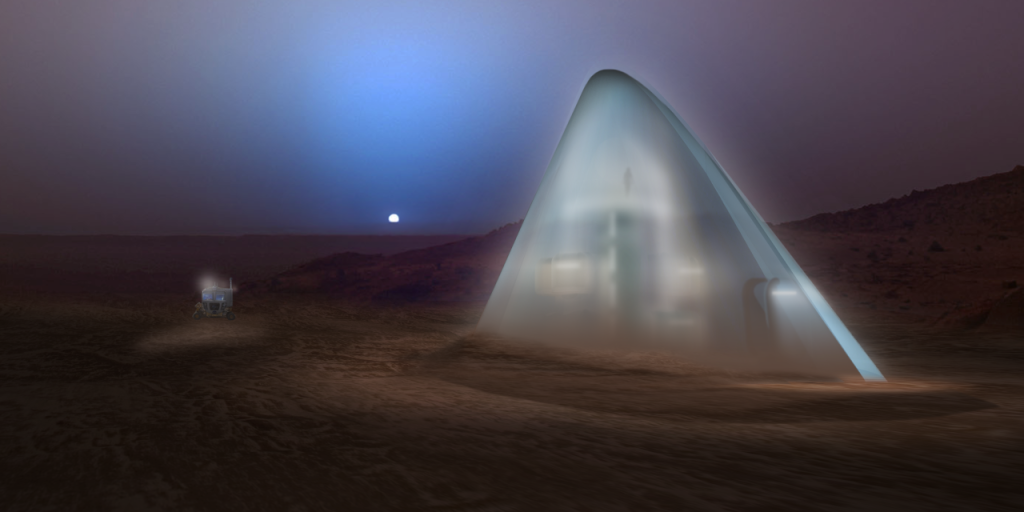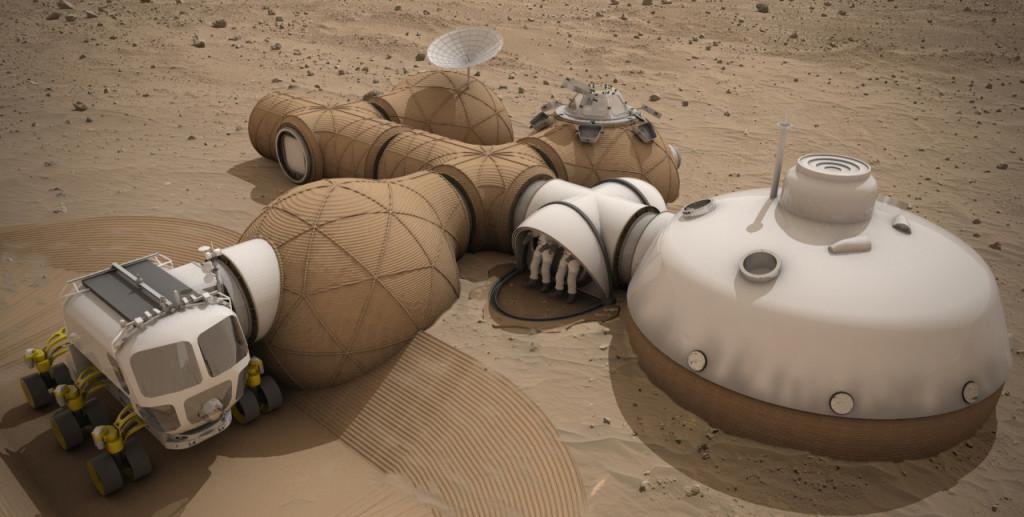 As NASA focuses on their discovery of liquid water on the surface of Mars, they also took the time to officially select the three winners for phase one of their 3D Printed Habitat Challenge. Back in August the 165 submissions were narrowed down to the top 30 semifinalists, who were then notified that their work would be more closely scrutinized by the judging panel. From the semifinalists, the panel selected the top three teams for the first phase of the challenge and announced the winners at this year’s New York Maker Faire. The three selected teams received a total of $40,000 in prizes to take them to the next phase of the competition.
As NASA focuses on their discovery of liquid water on the surface of Mars, they also took the time to officially select the three winners for phase one of their 3D Printed Habitat Challenge. Back in August the 165 submissions were narrowed down to the top 30 semifinalists, who were then notified that their work would be more closely scrutinized by the judging panel. From the semifinalists, the panel selected the top three teams for the first phase of the challenge and announced the winners at this year’s New York Maker Faire. The three selected teams received a total of $40,000 in prizes to take them to the next phase of the competition.
NASA and the National Additive Manufacturing Innovation Institute, America Makes, partnered up on the Habitat Design Challenge with a potential prize pool of $2.25 million. The challenge was launched back in May and tasked entrants to design a process to create 3D printed habitats for the colonization of other planets, primarily for Mars. The challenge would follow the teams through the design process, and for a handful of lucky winners, into the prototyping stage. The ultimate goal is the development of additive manufacturing construction technology that would lead to housing fabrication techniques that would benefit our first offworld colony and create sustainable housing solutions here on Earth. The winning three teams of phase one of the challenge were announced at a ceremony at 2015’s New York Maker Faire yesterday, Sunday, September 27.
The First Place prize of $25,000 was awarded to Team Space Exploration Architecture and Clouds Architecture Office for their ICE HOUSE design. The ICE HOUSE is essentially a Martian igloo, although it is certainly more beautiful. The concept was to design a structure that connected inhabitants to the outdoors, giving them a chance to thrive in their new environment. Selected in impressive timing with today’s stunning announcement, the concept relies on water to serve as the main construction component for the habitat. Because there is an abundance of water on Mars and consistently cold surface temperatures in the planet’s northern hemisphere, the ICE HOUSE is made using a unique 3D printing technique that harnesses the physics of water and prints by simply controlling where the water is deposited. This multi-layered shell of ice can be pressurized and acts as a radiation shield for the gardens and habitats inside of it.

First-place went to Team Space Exploration Architecture and Clouds Architecture Office of New York for ICE HOUSE.
The Second Place award of $15,000 was given to Team Gamma for their combination of material gathering robots and modular internal habitat structures. The semi-autonomous robots scour the surface for materials that can be converted into a protective shield around modular inflatable habitats. The outer shell is constructed using a multi-robot microwave regolith melting that solidifies the structure and then covers it with looser material to act as additional protection. The proposal focuses more on system redundancy and multi-functionality to reduce the amount of materials that needs to physically be sent to another planet.
LavaHive took home the Third Place for their habitat that repurposes the the shell of the Entry, Descent and Landing (EDL) system to act as the roof of the structure. Internally, an inflatable module underneath will act as the primary living space. Rovers will also turn the Martian surface into 3D printing material using a combination of sintering and ‘lava-casting’ to construct corridors that connect the main habitat and sub-habitat spaces. This will allow a greater flexibility to each mission by allowing the sub-habitats to be converted into research facilities, a greenhouse or workshops.
“The creativity and depth of the designs we’ve seen have impressed us. These teams were not only imaginative and artistic with their entries, but they also really took into account the life-dependent functionality our future space explorers will need in an off-Earth habitat,” said Monsi Roman, the Centennial Challenges Program Manager.
 The criteria that NASA and America Makes used for picking the winners included a wide range of concepts that teams would need to keep in mind during their design process. Obviously the judges would consider factors like the habitability of the final structure, how will it will function in real world environments, the selection of the Mars site and how 3D printable the concept would be. But they also considered the architectural concepts used, the team’s approach to design, the use of innovative applications of technology and the team’s design principles. You can see the top 30 designs from the first phase of the challenge here, and you can see the top 10 designs here.
The criteria that NASA and America Makes used for picking the winners included a wide range of concepts that teams would need to keep in mind during their design process. Obviously the judges would consider factors like the habitability of the final structure, how will it will function in real world environments, the selection of the Mars site and how 3D printable the concept would be. But they also considered the architectural concepts used, the team’s approach to design, the use of innovative applications of technology and the team’s design principles. You can see the top 30 designs from the first phase of the challenge here, and you can see the top 10 designs here.
As the design challenge moves into phase two it will be divided up into two levels. Level 1 is the Structural Member Competition which focuses on the technologies needed to fabrication and manufacture the habitat structures using components made from a combination of local materials and recycled parts, or from local materials alone. Level 2 is the On-Site Habitat Competition which challenges the competitors to fabricate a full-scale version of their habitat from local materials or from local materials combined with recycled parts. Both levels of the competition opened for registration on Sept. 26 with a $1.1 million prize up for grabs from the new teams.
What are your thoughts on the finalists’ designs? Let us know in the 3D Printing on Mars forum thread.
Subscribe to Our Email Newsletter
Stay up-to-date on all the latest news from the 3D printing industry and receive information and offers from third party vendors.
You May Also Like
3D Printing Unpeeled: New Arkema Material for HP, Saddle and Macro MEMS
A new Arkema material for MJF is said to reduce costs per part by up to 25% and have an 85% reusability ratio. HP 3D HR PA 12 S has been...
3D Printing News Briefs, January 20, 2024: FDM, LPBF, Underwater 3D Printer, Racing, & More
We’re starting off with a process certification in today’s 3D Printing News Briefs, and then moving on to research about solute trapping, laser powder bed fusion, and then moving on...
3D Printing Webinar and Event Roundup: December 3, 2023
We’ve got plenty of events and webinars coming up for you this week! Quickparts is having a Manufacturing Roadshow, America Makes is holding a Member Town Hall, Stratafest makes two...
Formnext 2023 Day Three: Slam Dunk
I’m high—high on trade show. I’ve met numerous new faces and reconnected with old friends, creating an absolutely wonderful atmosphere. The excitement is palpable over several emerging developments. The high...

































